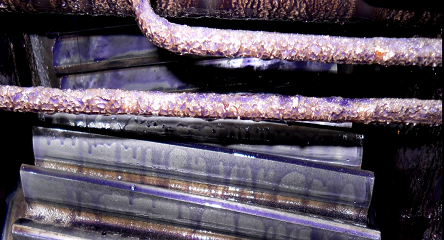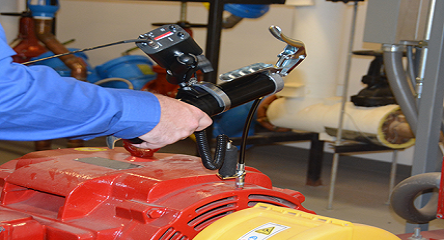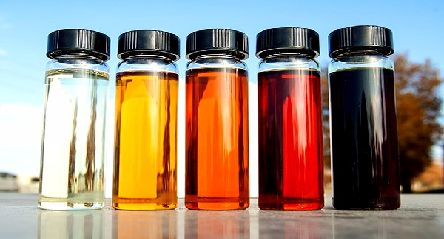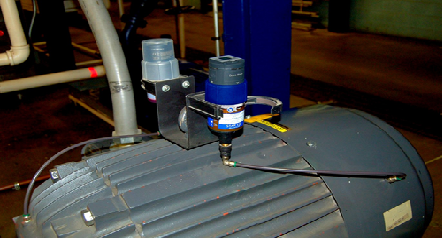Lubrication is an essential part of machinery maintenance for nearly every production facility. On average, lubricant purchases only amount to 3 percent of a maintenance budget, but lubrication-related activities can influence an estimated 40 percent of total maintenance costs.
In order to achieve optimum reliability and maximum benefits from a lubrication program, several factors need to be considered. These factors are summarized by the five R’s of lubrication:
· Right lubricant
· Right quantity
· Right time
· Right point
· Right method
The starting point of an effective lubrication program is the detailed mapping of all lubrication points, including their working conditions, lubrication requirements, and criticality. This information is needed to select the most suitable lubricant and the quantity of lubricant needed, as well as to calculate the adequate relubrication intervals. These are the first three R’s.
The fourth “R” refers to best practices, such as tagging and color-coding (or other methodology) of both lubrication points and tools to avoid cross-contamination.
Maintenance Costs Influenced by Lubrication-Related Activities
Besides lubricant costs, half of the acquired components will require relubrication. Over time, labor is mostly a result of machine failures typically caused by inadequate lubrication. In addition, approximately 5 percent of labor costs can be attributed to lubrication activities.
The fifth “R” can be defined once the application conditions, asset criticality, and maintenance strategy are analyzed. This will help you decide whether to automate each lubrication point. To make that decision, the pros and cons of automatic lubrication should also be understood and considered.
Once the five R’s are defined, you can determine the best way to lubricate a component with the resources available.
Criticality Analysis
A thorough criticality analysis of each asset will illustrate the impact of a failure in terms of:
· Overall production cost
· Overall maintenance cost
· Environmental impact
· Health and safety of personnel
The most critical assets are commonly the first targets of automatic lubrication.
Maintenance Strategy
The maturity level of a maintenance program (corrective, preventive, predictive, etc.) will dictate the skill and knowledge level required of personnel involved in lubrication-related activities.
As the maturity of maintenance and associated lubrication programs increases, so does the complexity of tasks that lubrication technicians must be capable of completing. These include activities such as:
· Lubricant analysis
· Continuous adjustment of lubrication routes
· Contamination control and fluid reconditioning
· Inspection routes
Therefore, as more mature maintenance programs are adopted, the areas where skilled maintenance technicians can add value to your operations need to be carefully considered. For example, are they best utilized performing manual relubrication, which can easily be automated, or by using their skills and knowledge to perform more analytical tasks, lubricant analyses, and making improvements to the lubrication program?
Benefits of Automated Lubrication
There are many advantages to using automatic lubrication systems. These include reduced waste and risk of bearing failure, cleanliness, less labor, and improved environmental health
and safety. The benefits of this system can be seen across multiple industries. For example, an automatic lubricating system would be ideal for pharmaceutical industries where they must deal with multiple types of equipment, harsh environments, and hundreds of lubrication points. By having this system, they ensure their machines are working at peak performance to produce a quality product every time.
Reduced Waste and Risk of Bearing Failure
Relubrication quantities are dictated by the physical space available in the bearing, while relubrication intervals are dictated by the working conditions that determine the degradation rate of the lubricant. This includes factors such as speed, load, temperature, and the type of bearing.
A single-point automatic lubrication system can deliver the right amount of grease at the right time to each lubrication point. This reduces both grease waste and the risk of bearing failure.
For example, consider a bearing that needs to be relubricated with 2 grams of grease every week. With a standard grease gun, this would mean that the bearing should receive about 1.3 “strokes.” However, manually delivering 0.3 strokes is difficult, and it would likely result in a full two strokes being delivered. In other words, the bearing would receive 3 grams instead of 2 grams each time.
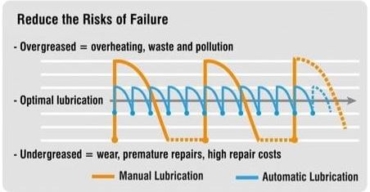
If we assume the technician is satisfied with two strokes because he doesn’t see any grease coming from the seals, after a year, the bearing will receive 156 grams (52 weeks times 3 grams per week) instead of 104 grams (52 weeks times 2 grams per week). This means that up to 52 grams (50 percent) of the grease will be wasted.
This example shows the benefit of accurately delivering the right quantity of lubricant (the second “R”), but what about the frequency of lubrication (the third “R”)?
Extending relubrication intervals beyond the calculated limits will expose the lubricant to excessive degradation and the bearing to lubricant starvation conditions. On the contrary, shortened relubrication intervals with adjusted quantities would renew the lubricant’s properties.
To illustrate this point, consider that on average, a human being requires about 2,000 calories per day. Would you rather consume your weekly total of 14,000 calories once a week or in nearly equal amounts over seven days?
Cleanliness
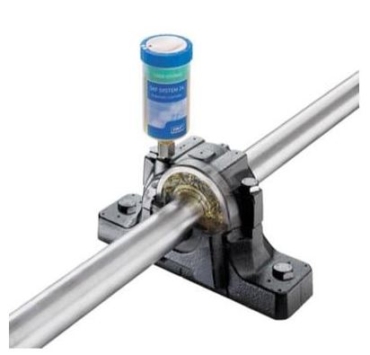
An automatic lubricator can supply a continuous and accurate flow of fresh and clean lubricant.
Lubricant contamination will also affect bearing life and increase the risk of failure. In manual lubrication programs, avoiding grease contamination can be a challenge.
Processes must be clean to ensure no external contamination ingresses into the grease, and each lubrication point should have a cap on its grease fitting. In addition, the utmost clean relubrication process for each point must be followed every time.
In the previous example, the technician will relubricate the given point 52 times a year. As a result, the bearing will be exposed 52 times to external contamination as well as to over-and under-lubrication.
By comparison, a properly installed single-point automatic lubricator can supply a continuous and accurate flow of fresh and clean lubricant, keeping the application in proper condition while at the same time preventing contaminant ingress.
Labor Savings
The simple task of pushing a lever on a grease gun to provide manual lubrication can be easily replaced by a machine. However, the real issue is whether you are getting the maximum value from your skilled maintenance technicians. Such personnel can manage a lubrication program through:
· Continuous improvement of the lubrication routes
· Implementation of a lubricant analysis program
· Implementation of a contamination control and oil reconditioning program
· Implementation of a leakage control program
Keep in mind that while deploying automatic lubrication systems can free personnel from time-consuming basic activities to provide extra value, it cannot replace staff who can deliver value at this level.
Environmental Health and Safety
Improper relubrication activities can have a significant impact on the environment. Consider again the grease waste calculations in the previous example. Now try to estimate the impact of this waste on the environment. Naturally, it depends on the disposal practices you implement at your facilities, but in basic environmental terms, the less waste the better.
Next, consider points that are difficult or even hazardous to access and the potential impact on your personnel. This is another area where automatic lubrication systems offer real benefits.
Common Problems
Simply using automation doesn’t guarantee success. Technology must be considered an instrument used to achieve a goal, but basic decisions and activities must still be performed. The following are typical mistakes that can jeopardize the potential benefits of deploying automatic lubrication.
Lack of Inspections
Having an automatic lubrication device doesn’t mean that the system won’t require any inspection. Regular inspection will help ensure the best results from an automated system. Inspection also will help to identify installation issues, such as damaged fitting and leaking pipes, and spot when it’s time to change or refill lubricants.
Moreover, lubrication routes must be updated, and manual lubrication tasks must be replaced with inspection tasks at an adequate interval. The frequency of inspection is less than that required for manual relubrication, but it still must be planned.
Improper Lubricant Selection
As a fundamental in any lubrication program, the lubricant selection must precede the lubrication system selection. After all, the lubricant that goes into the application is what lubricates, not the delivery system itself.
The lubricant and the automatic lubrication device must complement each other to ensure a better overall performance. Not all lubricants are suitable for all automatic lubrication systems, and the impact of a lubrication system on the structure of the lubricant depends on the technology of that given lubrication system.
Consequently, parameters like pumpability and oil separation must be considered when an automatic lubrication system is to be installed. Furthermore, relubrication intervals must be defined in a way that prevents the lubricant from being stationary inside the lubrication ducts, especially when exposed to extreme temperatures that could promote premature degradation. Failure to understand and act on these issues can affect the performance and associated benefits of deploying an automatic lubrication system.
Investment Costs
Deploying an automatic lubrication system requires some level of investment. To maximize the return on that investment, the key is to choose the right solution based on the requirements and criticality of the application. Typical solutions range from inexpensive single-point automatic lubricators to very complex centralized systems with various options for online monitoring. Determining which option is best for your application depends to a great extent on your critical analysis.
When to Use Automatic Lubrication
Automatic lubrication alone certainly is not the solution to all your lubrication issues. It must be properly understood to boost its potential benefits. However, there are solutions available in the market for virtually every application, so it is difficult to imagine that a critical application is not worth equipping with an automatic lubrication device.





